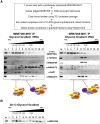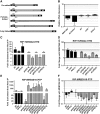MRB7260 is essential for productive protein-RNA interactions within the RNA editing substrate binding complex during trypanosome RNA editing
- PMID: 29330168
- PMCID: PMC5855954
- DOI: 10.1261/rna.065169.117
MRB7260 is essential for productive protein-RNA interactions within the RNA editing substrate binding complex during trypanosome RNA editing
Abstract
The trypanosome
Keywords: RNA editing substrate binding complex; Trypanosoma brucei; guide RNA; guide RNA binding complex; kinetoplastida; uridine insertion/deletion RNA editing.
© 2018 McAdams et al.; Published by Cold Spring Harbor Laboratory Press for the RNA Society.
Figures







Similar articles
-
MRB10130 is a RESC assembly factor that promotes kinetoplastid RNA editing initiation and progression.RNA. 2019 Sep;25(9):1177-1191. doi: 10.1261/rna.071902.119. Epub 2019 Jun 20. RNA. 2019. PMID: 31221726 Free PMC article.
-
Trypanosome RNAEditing Substrate Binding Complex integrity and function depends on the upstream action of RESC10.Nucleic Acids Res. 2021 Apr 6;49(6):3557-3572. doi: 10.1093/nar/gkab129. Nucleic Acids Res. 2021. PMID: 33677542 Free PMC article.
-
RESC14 and RESC8 cooperate to mediate RESC function and dynamics during trypanosome RNA editing.Nucleic Acids Res. 2024 Sep 9;52(16):9867-9885. doi: 10.1093/nar/gkae561. Nucleic Acids Res. 2024. PMID: 38967000 Free PMC article.
-
Mitochondrial RNA editing in trypanosomes: small RNAs in control.Biochimie. 2014 May;100:125-31. doi: 10.1016/j.biochi.2014.01.003. Epub 2014 Jan 17. Biochimie. 2014. PMID: 24440637 Free PMC article. Review.
-
Uridine insertion/deletion editing in trypanosomes: a playground for RNA-guided information transfer.Wiley Interdiscip Rev RNA. 2011 Sep-Oct;2(5):669-85. doi: 10.1002/wrna.82. Epub 2011 Mar 23. Wiley Interdiscip Rev RNA. 2011. PMID: 21823228 Free PMC article. Review.
Cited by
-
MRB10130 is a RESC assembly factor that promotes kinetoplastid RNA editing initiation and progression.RNA. 2019 Sep;25(9):1177-1191. doi: 10.1261/rna.071902.119. Epub 2019 Jun 20. RNA. 2019. PMID: 31221726 Free PMC article.
-
Dynamic RNA holo-editosomes with subcomplex variants: Insights into the control of trypanosome editing.Wiley Interdiscip Rev RNA. 2018 Nov;9(6):e1502. doi: 10.1002/wrna.1502. Epub 2018 Aug 12. Wiley Interdiscip Rev RNA. 2018. PMID: 30101566 Free PMC article. Review.
-
Structural basis for guide RNA selection by the RESC1-RESC2 complex.Nucleic Acids Res. 2023 May 22;51(9):4602-4612. doi: 10.1093/nar/gkad217. Nucleic Acids Res. 2023. PMID: 36999600 Free PMC article.
-
Protein features for assembly of the RNA editing helicase 2 subcomplex (REH2C) in Trypanosome holo-editosomes.PLoS One. 2019 Apr 29;14(4):e0211525. doi: 10.1371/journal.pone.0211525. eCollection 2019. PLoS One. 2019. PMID: 31034523 Free PMC article.
-
Translational control by Trypanosoma brucei DRBD18 contributes to the maintenance of the procyclic state.RNA. 2023 Dec;29(12):1881-1895. doi: 10.1261/rna.079625.123. Epub 2023 Sep 20. RNA. 2023. PMID: 37730435 Free PMC article.
References
Publication types
MeSH terms
Substances
Grants and funding
LinkOut - more resources
Full Text Sources
Other Literature Sources
Miscellaneous
